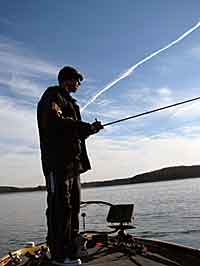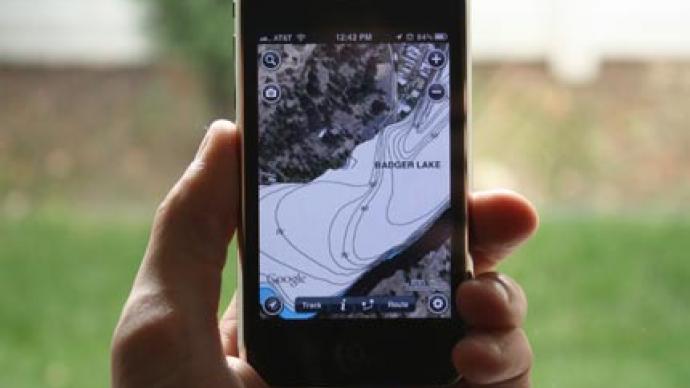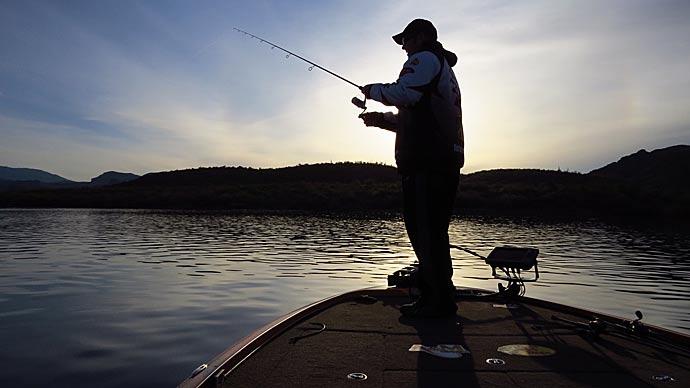
The best way to coach me for an important tournament is to prepare me for a tournament. Preparation has always been one of my strong points. By using a two-step preparation method I have developed, I enter new bodies of water and tournaments with extreme confidence. My two-step preparation method is as follows:
(1) At Home Research + (2) On The Water Fine-Tuning = Sweet Spots
At Home Research
This part of the preparation stage happens way before the tournament before you ever get to the lake. This is a crucial step in preparation. I've found the winning spot or pattern at home in over half of the tournaments I've ever won.
The first part of this step involves historical research on the tournament location. I review old bass fishing magazines (Bassmasters, Bassin, Bass Fishing, In-Fisherman, BASS Times, etc.), libraries, and the Internet, to find information on the lake. I am looking for what I call "buzz words." Buzz words are facts or information that keep coming up about a particular lake. For example, if, after researching three magazines, a newspaper article, and an Internet article, I keep seeing the word "Pink Worm" come up, I will consider this a buzzword. I will write down these buzz words and other facts about the lake in a notebook. I will keep several pages open in the notebook to continue to add notes during the next part of the at-home research stage.
The second part of the at-home research stage involves getting more current and up-to-date information. I contact local anglers or call local tackle shops or marinas. At this stage, I'm looking for general information only! No specifics! I never try and get exact information at this stage. I instead gather current, general information, like lake level, water temperature, water clarity, etc.
Finally, the third step of at-home research is map study. Map study is the most critical aspect of home research. During my map study phase, I can usually eliminate over half of any given lake and point out key areas that will hold fish. I start by ordering as many maps of the lake as possible. I do this because no two maps are usually the same. If I can gather five different maps, I can use all of them to cross-reference each other. After getting the maps, I begin breaking the lake down into manageable sections. I do this by thinking about seasonal patterns and bass migration routes. By understanding the universal seasonal migrations of bass, you can usually pinpoint potential fish-holding areas. In the most general of terms, the universal seasonal migration of bass is as follows:
- Bass will winter in the deepest, most vertical break areas.
- When water temperatures start warming up in early spring, bass will start migrating toward potential spawning areas, stopping first on main lake points, then on secondary points.
- During the spawn phase, the bass will seek out flats and coves with the correct bottom composition to spawn on.
- After the spawn, the fish will start heading back toward deeper water, staging on the same points they stopped at during pre-spawn.
- Summertime heat, finds most of the bass in deeper water main lake areas or heavy cover areas. Current can also be very crucial during the summer.
- The fall transition finds the bass following bait to feed up before the winter. Fall areas include the same flats and coves the bass used to spawn.
Again, that was the seasonal migration in the most general of terms. But, even in general terms, it lets you establish critical areas on the map. I mark these critical areas with different colored pens. I circle deep wintering and summering areas with a blue pen. I circle spawning flats and coves with a red pen. And I circle transition points between deep areas and spawning grounds with a black pen. I have it sectioned off when I get to the lake and have critical areas identified.
On The Water Fine Tuning
This is the pre-practice stage, where you go to the tournament location and start checking out the potential areas I have circled on my map. This is especially important when visiting new lakes. I use a combination of sonar work and search baits to try and find tournament-winning locations called sweet spots. I am looking for critical areas and concentrations of fish more than specific patterns during this stage. I like to spend 4 to 6 days pre-practicing for a big tournament as a general rule. Once I get to the lake and get into areas I have circled on my map, I use two methods to locate fish concentrations. The first method involves studying my sonar unit. I fast idle in a zig-zag pattern around the area with my Lowrance. I am looking for anything out of the ordinary. I am specifically looking for subtle points, humps, depressions, drop-offs, and the presents of baitfish. Once I see something different or something that catches my eye, I will drop a marker buoy on the spot. I will then idle some more, trying to define the boundaries of the spot. I am ready to use the second step on the water fine tunings with the marker buoy out.
Finally, this second step involves getting out my rod and reel and using search type transmission baits to get more information about the area. Generally, I use three transmission baits: crankbaits, Carolina Rigs, and heavy jigs. These three baits let me cover a lot of water and feel precise about what is on the bottom. With these transmission baits, I am trying to do two things, I am trying to make contact and find isolated cover, and I am also trying to catch a few fish. I will fan cast in the area around the buoy, trying to locate that isolated piece of cover. The isolated cover I'm looking for is objects like a rock, a stump, or an isolated patch of grass. Usually, when you can find an isolated cover piece on some form of structure change (bottom change), you have located what I call "sweet spots." Sweet spots are the kind of areas that win tournaments. They are the kind of areas that tend to hold large concentrations of fish. I will mark the area with my GPS unit once I have located a potential sweet spot and have hopefully caught a few fish. This will enable me to return to the exact area during tournament time.
After all this preparation, I am ready to fish the tournament. Again, the best form of coaching myself and confidence comes in preparation for me. By the start of the tournament's first day, I have a solid game plan and backup plans. I always try and put myself in a position to win the tournament. I put all of my faith in God and confidence in my ability. If I've had a bad tournament by the end of the tournament and did not catch the fish I wanted to, I have no regrets. I gave 100% during the tournament and in my preparation. I try and take failure in stride and learn from my mistakes. I will note what I did wrong and what the winners did. When I come back next time, I will be better prepared, and I will be ready to fish again.



